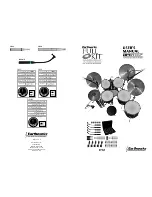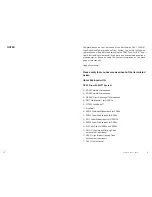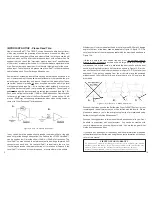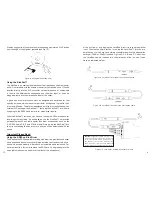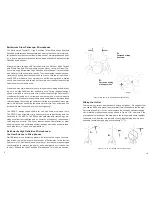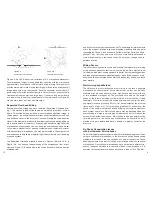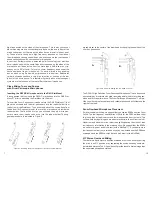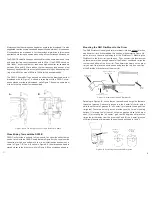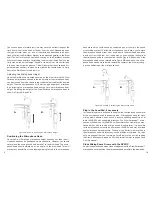
13
Figure 9-A
Figure 9-B
Horizontal X/Y Positioning
Vertical X/Y Positioning
Figures 9-A and 9-B show two variations of X/Y microphone placement.
For microphone “height” we suggests that you start with the microphone
approximately 2 feet above the drummer’s head. Moving them down will
provide more detail, while moving them higher will capture a wider over-all
image along with more room sound. Both the horizontal and vertical X/Y
positioning will provide excellent results in a drum booth or an acoustically
treated small room as well as a large room. If you are using a drum booth
or a room with a low ceiling, the horizontal X/Y version shown in Figure 9A
may be more ideal, as it requires less height.
Separated Overhead Miking
Another overhead miking approach is called “Separated Overhead Mik-
ing.” This method is ideal for those who do not have a drum room or drum
booth. This method also provides a much more defined stereo image. In
this approach, the microphones are farther apart from each other and can
be positioned closer to the drum set, if desired. Placing the overhead mics
closer to the drum set will reduce the ambient room sound while picking up
more subtle details of the drums. When using Earthworks High Definition
Microphones as overheads, you can bring the microphones down closer
to the drums without fear of hearing cymbal splash or splatter. However,
with conventional microphones you may be restricted in the height of the
overheads due to splashing or splattering of the cymbals in your recording
or sound system.
The Separated Overhead method is shown in Figures 10-A and 10-B. In
Figure 10-A, you can see the positioning of the microphones from a front
view and Figure 10-B shows where the microphones are pointed from an
overhead view.
A.
B.
and detail that other microphones cannot. These dramatic improvements
are in the areas of impulse response, diaphragm settling time and polar
technologies. Those who have heard Earthworks High Definition Micro-
phones™, say that they hear more of attack, more subtle details and a
more pristine quality in the sound than with any other microphones, re-
gardless of price.
Miking Drums
There are many ways to mic drums and it seems that most every recording
or live sound engineer has their own way of doing so. Our objective is not
to indicate which drum miking approach is better, but to make suggestions
and look at advantages and disadvantages of each. Every engineer or pro-
ducer uses their own methods to obtain the results they desire, and that’s
what matters.
Multi-microphone Method
The objective in multi-microphone drum miking is to place a separate
microphone on either most or all the elements of a drum set. Typically,
separate mics are used on snare, toms, high-hat and kick drum with one
or two overhead microphones. The overhead mics pick up the overall
sound of the drums including cymbals, which are typically not miked
separately. With this method, the mixing engineer can control the level,
and signal processing (limiting, EQ, etc.) for each element of the drum set
(toms, snare, hi-hat, etc.). This provides a great deal of control over the
sound of the entire drum set and allows bringing out certain patterns on
sock cymbal, snare, etc. Multi-miked drums may be desirable when you
are recording in a large room with high ambient sound as it will reduce the
amount of unwanted room sound. Multi-miking is also a popular practice
for miking drums in “live sound” applications such as concerts, as it will
provide more gain before feedback in addition to greater control of the
drum mix.
No Phase Cancellation Issues
with Earthworks
™
Microphones
One of the typical disadvantages in the multi-microphone approach, when
using conventional microphones, is the interactive microphone phasing
problems that result in the cancellation of certain frequencies. These
phasing problems are a result of the poor polar response of conventional
microphones. Conventional microphones have a drastically different fre-
quency response between the front and sides of the microphone. It is
common for conventional microphones to have a loss of 10 to 20 dB at
6
Содержание SR25
Страница 2: ......

